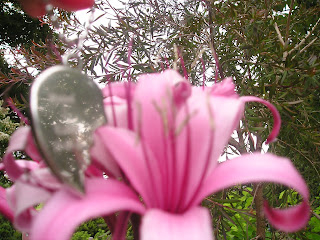 1. FRUIT - DRY WITH SEED
1. FRUIT - DRY WITH SEEDThis image is a dry Fig fruit and those clustered, round, and yellowish tiny beads located inside the fruit are the seeds. To preserve this fruit, it is usually solddry because it is highly perishable. This fruit is known for its sweetness as well as the antioxidant content it has. It is also a good source of calcium, iron, and potassium.
-------------------------------------------------------------------------------------------------
 2. RHIZOME
2. RHIZOMEThis Ginger is an example of a plant grown from a Rhizome. A Rhizome is a long stem, usually found underground, that grows roots and shoots from its nodes. Variety of plants can grow from a Rhizome due to its numerous root and shoot systems. A Rhizome has big chances of surviving the harsh winter and summer weather because it is located safely beneath the soil.
-------------------------------------------------------------------------------------------------
 3. HERMAPHRODITE
3. HERMAPHRODITEThis flowering plant is an example of a Hermaphrodite. Actually, all flowering plants are Hermaphrodite because they possess both the male and female sexual organs, therefore,
are able to produce and reproduce. Also, each flowering plant has a stamen and pistil,
which are both responsible for pollination.
-------------------------------------------------------------------------------------------------
 4. POLLEN
4. POLLENA Pollen is composed of dust-like and yellow colored tiny grains, and in this image,
are located in the center of a flower and attached to the anther. A Pollen contains the
male gametes within its pollen grains. This gametes are then responsible for reproduction
when transferred to another flowering plant containing the female gametes.
-------------------------------------------------------------------------------------------------
 5. POLLINATOR
5. POLLINATORA pollinator is usually a flying insect responsible for transferring pollen from one
flower to another. In this image, the pollinator is this bee collecting the pollen
grains. Each pollinator is assigned to those flowers that are able to attract it most.
Also, pollinators are "partners" of the flowering pants in reproduction. Most of the
pollen grains are transported by the pollinators, and some of it are being transferred
through the flow of the wind.
-------------------------------------------------------------------------------------------------
 6. CUTICLE LAYER OF A PLANT
6. CUTICLE LAYER OF A PLANTThis leaf found in a Begonia plant contains a waxy layer called "The Cuticle Layer".
The waxy feature prevents the leaf from drying out by trapping the moist/water
within the leaf, especially during a hot, sunny weather.
-------------------------------------------------------------------------------------------------
 7. ANGIOSPERM
7. ANGIOSPERMAngiosperm refers to all plants containing an ovary with its ovules inside and other
male and female reproductive organs. Most of the world's crops consists of
angiosperms. Angiosperms are very vital and serve an important role in the human's
lives as well as the world's ecosystem. They provide us food, medicines, paper
used in writing, and many more. They also play an important role on the ecosystem's
biogeochemical cycles.
-------------------------------------------------------------------------------------------------
 8. ANTHER & FILAMENT OF STAMEN
8. ANTHER & FILAMENT OF STAMENThis picture is an image of a flower with the stamen and its anther and filament.
The filament is the green colored stalk which transports the pollen from the
anther, which is responsible for picking up the pollen from the air, to the ovary.
The stamen as well as its anther and filament are parts of the female organs.
-------------------------------------------------------------------------------------------------
 9. KERATIN
9. KERATINKeratin is a tough and strong protein found on nails or hair. This substance makes our
nails and hair strong and uneasy to break. Keratin is formed from amino acids and by
keratinocytes, living cells found on body parts containing keratin.
-------------------------------------------------------------------------------------------------
 10. PINE CONE - FEMALE
10. PINE CONE - FEMALEFemale pine cones, like male pine cones, grow from any tree belonging from the
pine family. Female pine cones, however, are bigger in size than the male pine cones.
These cones also have ovules which becomes seeds when fertilized by pollen.
No comments:
Post a Comment